
“We are not these bodies. Let’s not get hung up on that.”
-George Harrison
As a functional fitness geek, I had always been curious to observe the inner workings of the human body up close and personal. So when a client of mine gave me tickets to see Bodies: The Exhibition several years ago, I was very excited to finally get that opportunity. Bodies is a display of actual human cadavers stripped of their skin and posed like statues. As anyone who’s seen the exhibit knows firsthand, it is quite an unbelievable thing to behold!
As I walked through the museum I observed the preserved bodies of people from all different walks of life. Men and women; athletes and sedentary folk; tall and short; fat and skinny. One thing stood out to me across the board: once these bodies had their flesh removed, each and every one of them had six pack abs underneath. After all, we all have the same anatomical make-up. The same muscles connected by the same tendons and ligaments to the same bones. Though we all look unique and individual, there is a basic formula that remains the same.

The problem for most people is that they have too much fat covering up those beautiful abdominal muscles! No matter how strong your abs become, you will never see that definition without a low body fat percentage. And while the belly is one of the last places that most people will hold onto fat, the same principle holds true for your whole body. If you’re training to get muscle tone, the only way to make that happen is by having a combination of muscle mass and a low body fat percentage. Bar training is a fantastic way to build muscle, but if you want to get a six pack, put that donut down and eat some vegetables.

If you want to get a six pack, put that donut down and eat some vegetables.
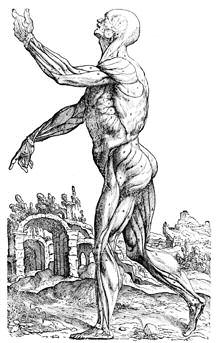
In order to understand why certain exercises are more effective than others, you must first understand the role that your abs play in the musculoskeletal system. The abs (or rectus abdominis as they are technically known) function primarily as a stabilizer muscle – they keep your torso upright while you’re standing, walking or performing other movements. For this reason, the best way to work your abs is to use them to stabilize your trunk in difficult positions. Rather than attempting to isolate them with crunches, I’ve found it more worthwhile to work my abs in the context of my entire body. You don’t need an ab roller or a fancy machine with a weight stack in order to make your abs rock hard either, you just need a bar to hang from. Pull-ups are actually a very effective abdominal exercise on their own. In fact, every single exercise discussed in this book will work your abs! However, additional core exercises will be helpful in your training.

How’s it hangin’?
A full hanging leg raise takes time to work towards. The first step in the progression is the bent knee hanging leg raise. As you begin to raise your knees, think about curling your hips forward to facilitate the movement. Keep in mind that your focus is to engage your abdominal muscles, which are attached to your pelvis, not your legs. Aim to tuck your knees all the way to your chest.
You’ll have to go very slowly to stay in control and you’ll probably only manage to do a couple of reps your first time out. This is okay; go for quality over quantity and be careful not to swing your body. If you find yourself swinging, try to stop the momentum by touching your feet to the ground in between reps. If you aren’t strong enough to do a full hanging knee raise up to your chest, work on doing half hanging knee raises with your knees getting to hip level.
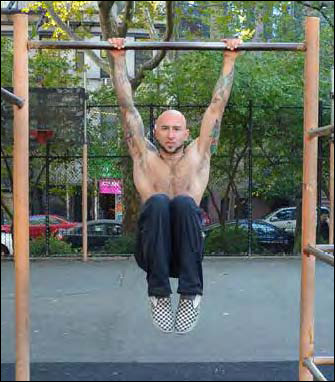
Keep in mind that your focus is to engage your abdominal muscles, which are attached to your pelvis, not your legs.
Another variation on the hanging knee raise is the hanging bicycle. Instead of bringing both knees up together, the knees are alternately raised one at a time, like you were riding an imaginary bicycle. This can be a slightly easier variation for anyone struggling to get both legs up together.

This can be a slightly easier variation for anyone struggling to get both legs up together.
Once you can do ten consecutive bent-knee leg raises, you’re ready to try it with your legs straight. This can be extra challenging for those of us with tight hamstrings. Think about rolling your hips forward as you lift your legs towards the bar. If you have to bend your knees a bit on the way up, this is fine. In time, work towards increasing your flexibility in order to keep your legs straight.

Think about rolling your hips forward as you lift your legs towards the bar.
After you’ve gotten comfortable with hanging leg raises, hanging leg circles are the next step in the progression. The idea is to move your legs in a giant circle around your entire body like a clock. Just make sure to do some reps counter-clockwise too! The circle motion will engage your obliques more than a straight leg raise, while still working the rectus abdominis.

The idea is to move your legs in a giant circle a around your entire body like a clock
Windshield Wipers are another challenging variation on the hanging leg raise. Like the name implies, the windshield wiper involves raising your legs to the bar and twisting from side to side like the windshield wipers of a car. You can think of it as only the top half of the circle. Go slow when performing these movements. Focus on good form rather than how many reps you can do. Three or four full range of motion windshield wipers can be quite difficult if you take your time with them.

Go slow when performing these movements.
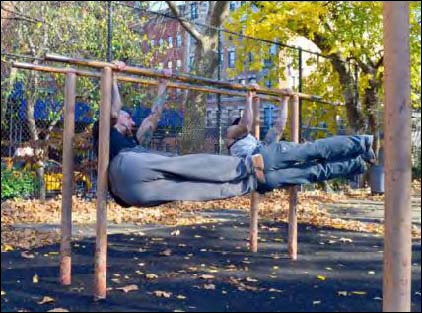
Try doing a hanging leg raise and freezing when your legs are extended at a right angle to your torso. The shape of your body should resemble the letter L. This position is called an L-Hold. (Kind of a no-brainer, right?) Since your legs are extended the furthest from your body during this part of the exercise, it is the most difficult part of the hanging leg raise to hold.

Though quite effective when executed on the bar, the L-hold is most commonly performed with the hands resting on the ground or holding parallel bars. The same ones that you use for dips are perfect. An L-hold performed in this fashion with the arms alongside the torso and palms below the hips is called an L-sit. How long a person can hold this position is an excellent measure of core strength. Though most commonly seen in gymnastics, the L-sit is a great exercise for anyone who is serious about building core strength. A thirty second L-sit in an excellent indication of a strong core. A minute puts you in an elite category of bodyweight strength.

The V-hold takes the L-hold to the next level. As the name implies, this pose is performed with the legs held in a position above parallel, causing the body to form a V-shape. To perform this move, you will need an exceptionally strong core as well as above average hamstring flexibility. Once you can hold the L for 30 seconds, you may begin training towards a V by gradually working your legs closer to your torso. Think about moving your hips forward (not just your legs) to facilitate this move.

Start by hanging from a bar with an overhand grip, then begin raising your legs with your knees bent. When your knees are all the way up to your chest, continue to roll your body around to the other side, keeping your legs tucked tight so they don’t hit the bar as you pass through. Then fully extend your body while trying to reach your toes toward the ground. This will give you a deep stretch in your shoulders, which is an added benefit of the exercise. Briefly hold the stretch, then slowly reverse your position.

Start by hanging from a bar with an overhand grip...
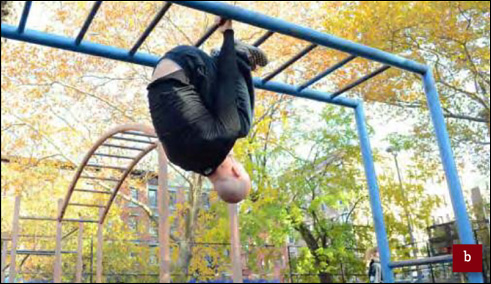
Skinning the Cat
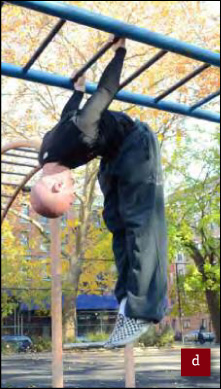
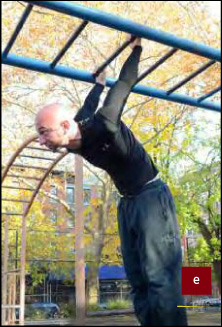
No animals were harmed in this process.
A rollover begins almost like a hanging leg raise but continues until your entire body rolls over on top of the bar, leaving you in the same position you’d find yourself in at the top of a muscle-up. To perform a rollover, pull with your arms as you bring your legs up as high as possible, eventually tossing them over the bar. You should feel your center of gravity shift to the opposite side. From here lift your torso, straighten your arms and prepare to drop into another rep. Typically some kipping is involved when performing rollovers, though exceptionally strong individuals can perform the movement slowly. (More on kipping and muscle-ups in the Chapter Five.)

Typically some kipping is involved when performing rollovers, though exceptionally strong individuals can perform the movement slowly.
The single arm variation of the hanging leg raise isn’t just one of the hardest abs exercises, it’s actually one of the hardest exercises in all of bar calisthenics. It’s honestly unfair to even call it an ab exercise since it requires tremendous grip and shoulder strength as well. Needless to say, it would be foolish to try this one before you get very comfortable with the two arm version. You’ll also need to practice hanging from one arm for a while first.
Once you can perform ten controlled reps of two arm hanging leg raises and hold yourself for at least 30 seconds from one arm, you might be able to do one or two single arm hanging leg raises. From there you can do several sets of just a couple reps at a time and eventually work your way up. You’ll have to go very slowly to avoid swinging around and spinning out of control when you perform this move. Remember to squeeze the bar tight and use the muscles of your back and shoulders to stabilize your body. Anyone who can perform ten reps of this exercise on each side is truly a master of their bodyweight.

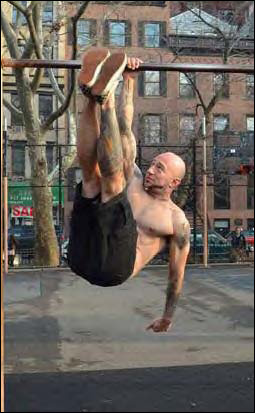
Anyone who can perform ten reps of this exercise on each side is truly a master of their bodyweight.
There is a lot more benefit to a strong core than just getting a six-pack, but of course aesthetics is a nice benefit of strength training. Just be careful not to get too carried away with it. While everyone is capable of achieving a flat, toned stomach, not everyone can have a perfect six pack.
The rectus abdominis is one muscle that runs from the sternum to the pelvis, but due to it’s ridged shape it can give the illusion of looking like six (or sometimes eight) different muscles. Some ridges in some people’s rectus abdominis form even cube shapes while some of us have more crooked looking abs. Even though the basic anatomy is the same, we all have slightly different looking muscles. It’s just like how we all have a mouth, a nose and two eyes, yet every person has a unique looking face.
In fact, the same is true for all your muscles - some people’s biceps have a nice peak and some don’t. Some guys might have a flat-looking chest, others might have a hard time building large shoulders. Different bodies are just shaped differently. Though individual genetics play a part in how your muscles look, nobody is genetically incapable of being lean and muscular. I work hard to make the best of what I got. Do likewise and you might just come close to reaching your full potential. It’s actually very simple - but that doesn’t mean it’s easy.

It used to drive me nuts that Danny’s abs are more symmetrical than mine, but I guess mine ain’t so bad either.